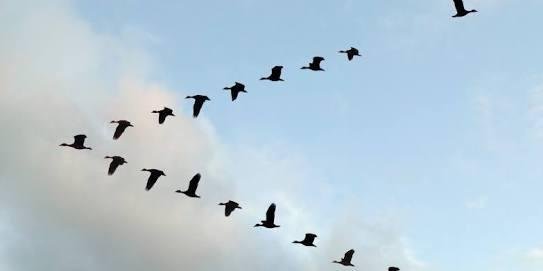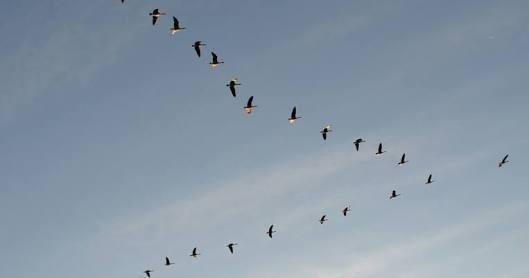Why Birds Fly In a V Formation
Anyone watching the autumn sky knows that
migrating birds fly in a V formation, but scientists
have long debated why. A new study of ibises finds
that these big-winged birds carefully position their
wingtips and sync their flapping, presumably to catchthe preceding bird’s updraft—and save energy
during flight.

There are two reasons birds might fly in a
V formation: It may make flight easier, or they’re
simply following the leader. Squadrons of planes cansave fuel by flying in a V formation, and many
scientists suspect that migrating birds do the same.
Models that treated flapping birds like fixed-wing
airplanes estimate that they save energy by draftingoff each other, but currents created by airplanes are far more stable than the oscillating eddies coming offof a bird. “Air gets pretty unpredictable behind a
flapping wing,” says James Usherwood, a locomotor
biomechanist at the Royal Veterinary College at the
University of London in Hatfield, where the research
took place.

The study, published in Nature, took advantage of
an existing project to reintroduce endangered
northern bald ibises (Geronticus eremita) to Europe.
Scientists used a microlight plane to show
hand-raised birds their ancestral migration route
from Austria to Italy. A flock of 14 juveniles carried
data loggers specially built by Usherwood and his lab.
The device’s GPS determined each bird’s flight
position to within 30 cm, and an accelerometer
showed the timing of the wing flaps.
Just as aerodynamic estimates would predict, the
birds positioned themselves to fly just behind and tothe side of the bird in front, timing their wing beats
to catch the uplifting eddies. When a bird flew
directly behind another, the timing of the flapping
reversed so that it could minimize the effects of the
downdraft coming off the back of the bird’s body.
“We didn’t think this was possible,” Usherwood
says, considering that the feat requires careful
flight and incredible awareness of one’s neighbors.
“Perhaps these big V formation birds can be thought
of quite like an airplane with wings that go up and down.
Scientists do not know how the birds find
that aerodynamic sweet spot, but they suspect that
the animals align themselves either by sight or
by sensing air currents through their feathers.
Alternatively, they may move around until they find
the location with the least resistance. In future
studies, the researchers will switch to more common
birds, such as pigeons or geese. They plan to
investigate how the animals decide who sets the
course and the pace, and whether a mistake made by the leader can ripple through the rest of the flock to
cause traffic jams
Resteemed your article. This article was resteemed because you are part of the New Steemians project. You can learn more about it here: https://steemit.com/introduceyourself/@gaman/new-steemians-project-launch